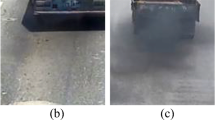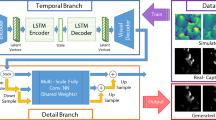Abstract
Smoke removal has been a challenging problem which refers to the process of retrieving clear images from the smoky ones. It has an extensive demand while the performances of existing image desmoking methods have limitations owing to the homogeneous medium based model, hand-crafted features, and insufficient datasets. Unlike the existing desmoking methods using an atmospheric scattering model, the proposed method utilizes a general deblurring model. Inspired by Generative Adversarial Network (GAN), we propose an end-to-end attentive DesmokeGAN which implements the visual attention into the generative network to effectively learn the smoke features and their surroundings. The architecture of critic network is identical to PatchGAN by adding multi-component loss function to the image patch. Due to the scarce of various and quality smoke datasets, a graphics rendering engine is used to synthesize the smoky images. The quantitative and qualitative results show that the designed framework performs better than the recent state-of-the-art desmoking approaches on both synthetic and real images in indoor and outdoor scenes, especially for the thick smoky images.










Similar content being viewed by others
References
Hasikin K, Mat Isa NA (2015) Adaptive fuzzy intensity measure enhancement technique for non-uniform illumination and low-contrast images. SIViP 9(6):1419–1442
Rahman S et al (2016) (2016) An adaptive gamma correction for image enhancement. Eurasip J Image Video Process 1:35
Seow M-J, Asari VK (2006) Ratio rule and homomorphic filter for enhancement of digital colour image. Neurocomputing 69(7):954–958
Li S et al (2019) Real-time smoke removal for the surveillance images under fire scenario. SIViP 13(5):1037–1043
Fattal R, (2008) Single image dehazing. In international conference on computer graphics and interactive techniques
Baid A, et al., (2017) Joint desmoking, specularity removal, and denoising of laparoscopy images via graphical models and Bayesian inference. In international symposium on biomedical imaging. Melbourne, VIC
Kotwal A, Bhalodia R and Awate SP (2016) Joint desmoking and denoising of laparoscopy images. In international symposium on biomedical imaging. Melbourne, VIC
He K, Sun J, and Tang X (2009) Single image haze removal using dark channel prior. In: Computer vision and pattern recognition, pp 1956–1963
Pei S, Chen Y, Chiu Y (2019) Single image desmoking using haze image model and human visual system. J Electron Imaging 28(04):043007
Meng G et al. (2013) Efficient image dehazing with boundary constraint and contextual regularization. In international conference on computer vision
Sulami M et al. (2014) Automatic recovery of the atmospheric light in hazy images. In IEEE international conference on computational photography Santa Clara, CA
Zhu Q, Mai J, Shao L (2015) A fast single image haze removal algorithm using color attenuation prior. IEEE Trans Image Process 24(11):3522–3533
Li B et al. (2017) AOD-Net: all-in-one dehazing network. In international conference on computer vision
Chen D, et al. (2019) Gated context aggregation network for image dehazing and deraining. In IEEE winter conference on applications of computer vision
He L, Bai J, Ru L (2019) Haze removal using aggregated resolution convolution network. IEEE Access 7:123698–123709
Raj NB and Venkateswaran N (2018) Single image haze removal using a generative adversarial network arXiv: computer vision and pattern recognition
Li R et al. (2018) Single image dehazing via conditional generative adversarial network. In computer vision and pattern recognition
Zhang H, Sindagi VA and Patel VM (2017) Joint transmission map estimation and dehazing using deep networks. arXiv: computer vision and pattern recognition
Engin D, Genc A, and Ekenel HK (2018) Cycle-dehaze: enhanced cycleGAN for single image dehazing. In computer vision and pattern recognition
Yang X, Xu Z, and Luo J (2018) Towards perceptual image dehazing by physics-based disentanglement and adversarial training. In national conference on artificial intelligence
Tan M et al (2019) Image-dehazing method based on the fusion coding of contours and colors. IEEE Access 7:147857–147871
Tchaka K, Pawar V and Stoyanov D (2017) Chromaticity based smoke removal in endoscopic images. In Proceedings of SPIE. Orlando, Florida, US
Nishino K, Kratz L, Lombardi S (2012) Bayesian Defogging. Int J Comput Vision 98(3):263–278
Larochelle, H. and Hinton GE (2010) Learning to combine foveal glimpses with a third-order Boltzmann machine. In neural information processing systems
Wang F et al. (2017) Residual attention network for image classification. In computer vision and pattern recognition
Hu J et al. (2020) Squeeze-and-excitation networks. IEEE Trans Pattern Anal Mach Intell 42(8):2011–2023
Vaswani A et al. (2017) Attention is all you need. In neural information processing systems
Parmar N et al. (2018) Image transformer. arXiv: computer vision and pattern recognition
Wang X et al. (2018) Non-local neural networks. In computer vision and pattern recognition
Zhang Y et al. (2018) Image super-resolution using very deep residual channel attention networks. In European conference on computer vision
Qin X et al. (2019) FFA-Net: feature fusion attention network for single image dehazing. arXiv: computer vision and pattern recognition
Goodfellow I et al. (2014) Generative adversarial nets. In advances in neural information processing systems
Gulrajani I, et al. (2017) Improved training of wasserstein GANs. arXiv: Learning
Isola, P., et al., (2017) Image-to-Image translation with conditional adversarial networks. In computer vision and pattern recognition. Honolulu, HI
Ronneberger O, Fischer P, and Brox T (2015) U-Net: convolutional networks for biomedical image segmentation. In medical image computing and computer assisted intervention
Mirza M and Osindero S, (2014) Conditional generative adversarial nets. arXiv: learning
Bolkar S et al. (2018) Deep smoke removal from minimally invasive surgery videos. In proceedings of IEEE international conference on image processing
Malav R et al. (2018) DHSGAN: An end to end dehazing network for fog and smoke. In: Jawahar C, Li H, Mori G, Schindler K (Eds) Asian conference on computer vision
Sidorov O, Wang C, and Cheikh FA (2019) Generative smoke removal. arXiv: computer vision and pattern recognition
Chen L et al (2019) De-smokeGCN: generative cooperative networks for joint surgical smoke detection and removal. IEEE Trans Med Imaging. 39(5):1–1
Cai B et al (2016) DehazeNet: an end-to-end system for single image haze removal. IEEE Trans Image Process 25(11):5187–5198
Tang K, Yang J and Wang J, (2014) Investigating haze-relevant features in a learning framework for image dehazing. In computer vision and pattern recognition
He K et al. (2016) Deep residual learning for image recognition. In Proceedings of the IEEE conference on computer vision and pattern recognition
Xu, B., et al., (2015) Empirical evaluation of rectified activations in convolutional network. arXiv: learning
Ioffe S and Szegedy C (2015) Batch normalization: accelerating deep network training by reducing internal covariate shift. arXiv: learning
Arjovsky M, Chintala S and Bottou L (2017) Wasserstein gan. ArXiv e-prints
Mahapatra D et al. (2017) Image super resolution using generative adversarial networks and local saliency maps for retinal image analysis. In international conference on medical image computing and computer-assisted intervention. Springer
Zeiler MD and Fergus R (2014) Visualizing and understanding convolutional networks. in European conference on computer vision. Springer
Nah S, Hyun Kim T and Mu Lee K (2017) Deep multi-scale convolutional neural network for dynamic scene deblurring. In Proceedings of the IEEE conference on computer vision and pattern recognition
Ledig C et al. (2017) Photo-realistic single image super-resolution using a generative adversarial network. In Proceedings of the IEEE conference on computer vision and pattern recognition
Zhang H, Sindagi VA, and Patel VM (2017) Image de-raining using a conditional generative adversarial network. arXiv: computer vision and pattern recognition
Simonyan K and Zisserman A (2014) Very deep convolutional networks for large-scale image recognition. arXiv: computer vision and pattern recognition
Silberman N et al. (2012) Indoor segmentation and support inference from RGBD images. In european conference on computer vision
Li B et al (2019) Benchmarking Single-Image Dehazing and Beyond. IEEE Trans Image Process 28(1):492–505
Abadi M et al. (2015) Tensorflow: large-scale machine learning on heterogeneous distributed systems. arXiv: distributed, parallel, and cluster computing
Kingma DP and Ba J (2014) Adam: a method for stochastic optimization. arXiv: learning
Wang Z et al (2004) Image quality assessment: from error visibility to structural similarity. IEEE Trans Image Process 13(4):600–612
Author information
Authors and Affiliations
Corresponding authors
Additional information
Publisher's note
Springer Nature remains neutral with regard to jurisdictional claims in published maps and institutional affiliations.
Rights and permissions
About this article
Cite this article
Huang, Y., Chen, X., Xu, L. et al. Single Image Desmoking via Attentive Generative Adversarial Network for Smoke Detection Process. Fire Technol 57, 3021–3040 (2021). https://doi.org/10.1007/s10694-021-01096-z
Received:
Accepted:
Published:
Issue Date:
DOI: https://doi.org/10.1007/s10694-021-01096-z




